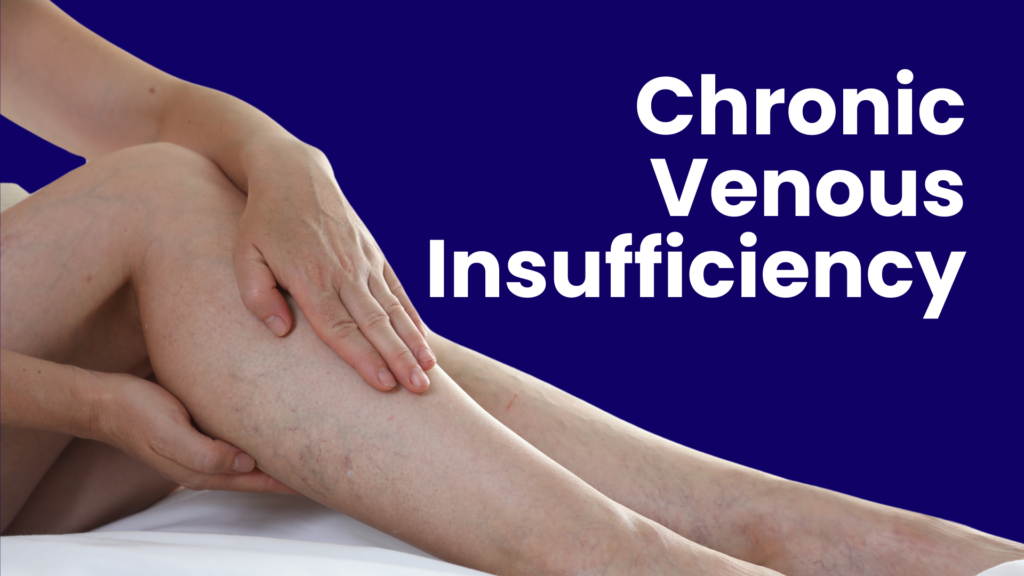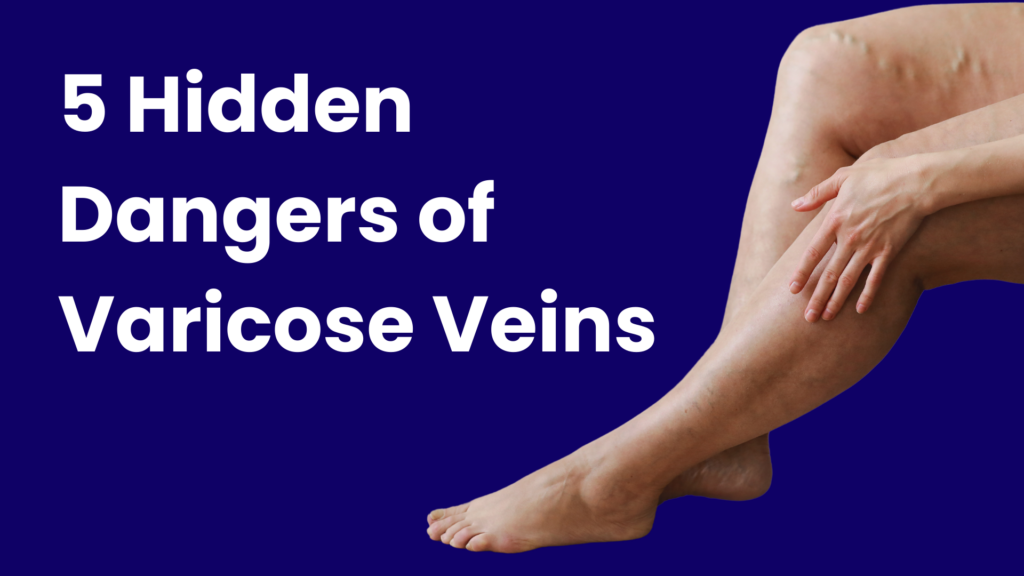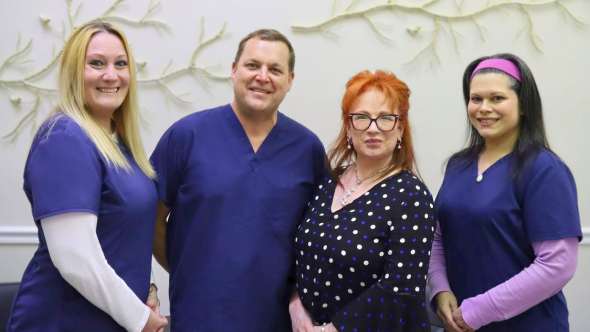In this article, we’ll discuss one of the most difficult and uncomfortable vein conditions: venous ulcers.
Venous ulcers, sometimes called leg ulcers, occur in up to 3 in 1000 people. Most patients are older(1).
And this condition is stubborn! Only 60% of these ulcers heal after 12 weeks. After healing, most experience the return of ulcers within three weeks(2).
This condition can be painful and debilitating. It affects not only the physical health but also the mental health of millions worldwide. Fortunately, treatment is out there.
Let’s learn more about venous ulcers—their causes, symptoms, diagnoses, and treatment options.
Table of Contents
ToggleWhat are Venous Ulcers?
Venous ulcers are a sign of venous insufficiency. This is when the valves in your veins have trouble returning blood to your heart. The blood then backs up in the veins, pooling in the lower legs.
This continuous fluid buildup adds pressure, causing ulcers to develop. These usually appear above the ankle(3).
What causes venous ulcers?
Here are the most common behaviors or lifestyle factors associated with venous ulcers(6):
- Prolonged sitting or standing
- Obesity
- Age
- Family history
- Previous injury
- Pregnancy
Certain causes are preventable. But others… not so much.
Diseases related to chronic venous insufficiency can lead to and exacerbate venous ulcers.
One example is deep vein thrombosis (DVT). Those experiencing DVT develop blood clots in the deep veins of their legs. These clots obstruct blood flow and, eventually, damage the veins(4).
Varicose veins are another. These are swollen, enlarged veins near the skin’s surface that appear blue or purple. They show when veins become weak or damaged(5).
You can experience chronic venous insufficiency without the presence of varicose veins. But many people deal with both at the same time.
Venous Ulcers Symptoms
Like all sores, venous ulcers come with a variety of side effects, such as(7):
Pain. This is a common side effect. Additional inflammation or an infection can worsen the pain.
Itching. Ulcers might feel itchy, especially as they are healing.
Swelling. Like most vein diseases, patients with venous ulcers can experience swelling or edema in their legs.
Discoloration. The discoloration stems from the breakdown of red blood cells. The skin near the ulcers might appear reddish-brown(8).
Drainage. Sores may produce a clear, yellow, or greenish-looking discharge. This may be a sign of infection.
Venous ulcers often take a long time to heal due to poor circulation stemming from venous insufficiency(9) (yes, the same insufficiency that caused them to appear in the first place!).
Venous Ulcer Diagnosis
If you suspect you have venous ulcers, you’ll first need to get a diagnosis.
Make an appointment with your doctor. They will follow several steps to confirm if you are suffering from this condition(10):
Review your medical history.
Your doctor will evaluate your medical history. They will ask questions about your symptoms, family history (especially vein disease), and lifestyle.
Perform a physical exam.
Your doctor will then inspect your legs for signs of venous insufficiency and ulcers. They’ll assess the size, depth, and drainage of ulcers. They’ll also look for other skin changes in the area.
Order a Doppler ultrasound.
Your doctor may order a Doppler ultrasound to assess blood flow. This noninvasive test uses sound waves to generate images showing blood flow. This ultrasound can help identify the location and severity of any vein problem.
Order additional testing.
The doctor may order other tests to rule out similar ailments or identify related medical concerns. For example, diabetes can impede wound healing, so they may test for diabetes as well.
Medical Treatment for Venous Ulcers
Your doctor will likely recommend medical treatment options focused on healing vein disease. This, in turn, will cause the venous ulcer concern to subside.
It is still important to care for ulcers to prevent the condition from worsening(11):
Wound care
Treat ulcers like any other wounds on the body. Your doctor may recommend cleaning with saline solution or applying topical treatments. Dressing wounds with bandages can promote healing and prevent infection.
Maintain your skin
Make sure your skin is clean and dry. Avoid ingredients such as lanolin, neomycin, and nickel in topical products(7).
Pain management medications
When venous ulcers become inflamed or infected, they can become painful. Over-the-counter pain relievers or certain topical creams can help(12).
To tackle the root of the problem, you’ll want to turn to treatments for vein disease.
The following treatments tackle venous insufficiency to reduce symptoms and improve blood flow:
Compression therapy
Compression stockings apply pressure to the legs, helping blood travel upward and reducing swelling(13). Many different compression stocking options exist, varying in strength and style.
Radiofrequency ablation
Radiofrequency ablation (RFA) is a minimally invasive procedure. Heat is used to seal varicose veins shut, which directs blood flow to healthier veins. This is best performed early on to help improve healing and decrease recurrence rates(14).
Sclerotherapy
This is another minimally invasive procedure, though often used for cosmetic purposes. A solution is injected into affected veins causing them to collapse. Sclerotherapy can improve symptoms of venous insufficiency(15).
Preventing and Reducing Venous Ulcers
Lifestyle changes can lessen the severity of venous insufficiency and venous ulcers and may also prevent them.
Here are some tactics that you can try out to reduce your chances of developing venous ulcers(17):
Move – and elevate – your legs
It’s not a good idea to sit or stand for too long. Take some time to kick your legs up for a bit. Try elevating them against a wall, or hit a yoga pose that gets your legs up in the air.
Manage your weight
Every extra pound extra adds pressure on your legs, impeding blood flow. Instill healthy habits early on to help prevent venous disease later on.
Eat a healthy diet
Eat a diet rich in fruits, vegetables, whole grains, and lean proteins. Limit your sodium intake if you are at high risk for vein disease. Extra salt may lead to fluid retention.
Avoid smoking
There are many health-related reasons to avoid cigarettes – vein health included! Smoking can constrict your blood vessels and impair circulation. This can lead to venous insufficiency down the line.
Stay active
Move those legs! Aim for 150 minutes of weekly exercise to reduce your risk of developing venous ulcers. Walking, swimming, and cycling can improve blood circulation in your legs.
Find an emotional outlet
Since sores are visible on the skin, patients could feel embarrassed. Pain from the wounds can also be exhausting. Talk to a family member or friend, journal, or meditate – build your support system.
Conclusion
Understanding venous ulcers is more than just about expanding your knowledge. It is also about taking control of your health and well-being and being able to support those around you.
It’s important to be able to identify the signs of venous ulcers. This will help you know when to seek medical treatment and when lifestyle changes are necessary. It will also prevent further medical trouble and improve your quality of life.
If you or a loved one are suffering from venous ulcers and feel pain and discomfort every day, there is help out there for you.
The team of experts at Bucks County Center for Vein Medicine is here to provide solutions for vein conditions of all kinds. Our clinic is professional and patient-focused, providing top-of-the-line care and modern treatments for those with vein-related medical concerns.
Take the first steps toward conquering your venous ulcers. Book your consultation today!
References
- Nelson, E. A., & Adderley, U. (2016). Venous leg ulcers. BMJ Clinical Evidence, 2016. https://www.ncbi.nlm.nih.gov/pmc/articles/PMC4714578/
- Probst, S., Weller, C. D., Bobbink, P., Saini, C., Pugliese, M., Skinner, M. B., & Gethin, G. (2021). Prevalence and incidence of venous leg ulcers—A protocol for a systematic review. Systematic Reviews, 10. https://doi.org/10.1186/s13643-021-01697-3
- https://medlineplus.gov/ency/patientinstructions/000744.htm
- https://www.nhs.uk/conditions/leg-ulcer/causes/
- https://www.templehealth.org/services/conditions/varicose-veins-chronic-venous-insufficiency
- https://www.nyp.org/vascular/venous-insufficiency-and-ulcers
- https://www.cedars-sinai.org/health-library/diseases-and-conditions/v/venous-ulcers.html
- Caggiati A, Rosi C, Casini A, Cirenza M, Petrozza V, Acconcia MC, Zamboni P. Skin iron deposition characterises lipodermatosclerosis and leg ulcer. Eur J Vasc Endovasc Surg. 2010 Dec;40(6):777-82. doi: 10.1016/j.ejvs.2010.08.015. Epub 2010 Sep 28. PMID: 20880725.
- Raffetto, J. D., Ligi, D., Maniscalco, R., Khalil, R. A., & Mannello, F. (2021). Why Venous Leg Ulcers Have Difficulty Healing: Overview on Pathophysiology, Clinical Consequences, and Treatment. Journal of Clinical Medicine, 10(1). https://doi.org/10.3390/jcm10010029
- https://www.nhs.uk/conditions/leg-ulcer/diagnosis/
- Dogra, S., & Rai, R. (2014). Venous leg ulcer: Topical treatment, dressings and surgical debridement. Indian Dermatology Online Journal, 5(3), 371-373. https://doi.org/10.4103/2229-5178.137820
- Imbernon-Moya A, Ortiz-de Frutos FJ, Sanjuan-Alvarez M, Portero-Sanchez I, Merinero-Palomares R, Alcazar V. Pain and analgesic drugs in chronic venous ulcers with topical sevoflurane use. J Vasc Surg. 2018 Sep;68(3):830-835. doi: 10.1016/j.jvs.2017.11.071. Epub 2018 Feb 13. PMID: 29452834.
- Patton, D., Avsar, P., Sayeh, A., Budri, A., Walsh, S., Nugent, L., Harkin, D., Cayce, J., Corcoran, M., Gaztambide, M., & Moore, Z. (2023). A meta‐review of the impact of compression therapy on venous leg ulcer healing. International Wound Journal, 20(2), 430-447. https://doi.org/10.1111/iwj.13891
- Bonkemeyer Millan S, Gan R, Townsend PE. Venous Ulcers: Diagnosis and Treatment. Am Fam Physician. 2019 Sep 1;100(5):298-305. PMID: 31478635.
- Worthington-Kirsch, R. L. (2005). Injection Sclerotherapy. Seminars in Interventional Radiology, 22(3), 209-217. https://doi.org/10.1055/s-2005-921954
- https://nyulangone.org/conditions/chronic-venous-insufficiency/treatments/surgery-for-chronic-venous-insufficiency
- Shenoy, M. M. (2014). Prevention of venous leg ulcer recurrence. Indian Dermatology Online Journal, 5(3), 386-389. https://doi.org/10.4103/2229-5178.137824



